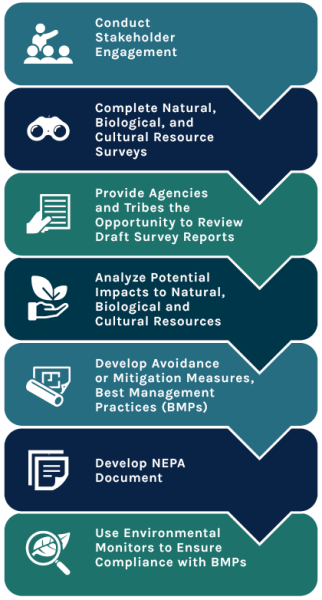 CBP is committed to environmental and cultural stewardship while performing our core missions of border security and the facilitation of legitimate trade and travel. CBP works hand-in-hand with other Federal, Tribal, state, and local agencies, as well as non-governmental organizations (NGOs), to fulfill environmental compliance regulations and to ensure protection of the Nation's natural and cultural resources. Additionally, CBP works diligently to integrate responsible environmental practices - including incorporating sustainable practices - into all aspects of our decision making and operations.
CBP is committed to environmental and cultural stewardship while performing our core missions of border security and the facilitation of legitimate trade and travel. CBP works hand-in-hand with other Federal, Tribal, state, and local agencies, as well as non-governmental organizations (NGOs), to fulfill environmental compliance regulations and to ensure protection of the Nation's natural and cultural resources. Additionally, CBP works diligently to integrate responsible environmental practices - including incorporating sustainable practices - into all aspects of our decision making and operations.
Environmental Planning
CBP is committed to responsible environmental stewardship and engages in environmental planning for all construction and maintenance projects—including facilities, physical barriers, roads, lighting, surveillance systems and detection technology.
CBP’s environmental planning process includes 30- to 60-day public comment periods to gather information and data from interested stakeholders about potential impacts to the environment, habitat, wildlife, culture, quality of life and commerce—including socioeconomic impacts—that may result from the proposed project. To date, CBP has reviewed and considered feedback provided by tens of thousands of comments from stakeholders.
Environmental Planning Process

CBP’s environmental planning includes the preparation of an Environmental Assessment (EA) or Environmental Impact Statement (EIS), in compliance with the National Environmental Policy Act (NEPA). For some projects, the Secretary of the Department of Homeland Security (DHS) may determine it is necessary to exercise his or her authority in Section 102(c) of the Illegal Immigration Reform and Immigrant Responsibility Act of 1996 (IIRIRA) to waive certain environmental laws, including NEPA, to expedite construction of border infrastructure. In this case, CBP seeks to accomplish responsible environmental planning within a managed timeframe to meet operational needs and prepares and implements an Environmental Stewardship Plan (ESP).
Public Involvement
CBP believes environmental stewardship is best achieved through community involvement. If you have data or information that can inform our environmental planning, we want to hear from you!
| States |
|---|
| Arizona |
| California |
| Northern Border |
| Texas |
For Additional Information
- Sustainability and Resilience
- Preserving Cultural Resources
- For general questions about CBP's environmental planning process, please email the CBP Environmental Program.


